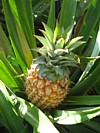|
pineapple
Fruit of the Ananas comosus,
a prickly plant that flourishes well in dry ground and is mainly cultivated in the provinces of
Chonburi,
Rayong,
Chiang Rai,
Prachuap Khirikhan, and
Phuket.
It takes about 2 years to grow a plant that yields and fruits take between 6 to
9 months to mature. There are usually only two or three fruits on each plant and
grow from the middle of the plant, with each producing fruit up to three times
in their lifespan, which lasts about 4 years. Afterwards the plants needs to be replaced by new shoots,
which in fact consist of the leaves on top of the fruits.
Depending on the species, the leaves
of both the plant and those on top of the fruit may either have smooth or
serrated edges, or may have spikes on them. Pineapples are picked by hand to allow the farmer to check the quality of each
crop individually, before harvesting it. Thai pineapple farmers use a stick to
tap the fruit for quality control, relying on the sound produced to determine
ripeness. A clear, solid sound indicates a ripe pineapple, while a hollow or
dull sound suggests it is unripe or overripe. This efficient and non-invasive
method allows farmers to quickly assess large quantities of pineapples, ensuring
only high-quality fruit reaches the market. Consumers can determine if a
pineapple is ripe by its smell and colour. A sweet aroma at the base indicates
ripeness, while no smell suggests underripeness and a sour smell indicates
overripeness. Whereas a mostly golden yellow colour is ideal, some green will be
good too, but an all-green
pineapple is likely too tart, whilst a dark orange base means the fruit is
probably overripe. Pineapple is a non-climacteric fruit, meaning it only ripens
on the plant and not after it's harvested. So, an unripe pineapple won't sweeten
over time. There is also no issue storing pineapples with other fruits and
vegetables, as they emit very little ethylene gas, a naturally occurring
ripening hormone. This means a pineapple's presence wonít accelerate the
ripening process of nearby foods. Although pineapples donít ripen off the plant,
they can still be affected by ethylene. However, their thick, durable skin
provides protection from the ethylene emitted by other fruits. Pineapples or representations of them are also often offered in temples and
shrines, especially in Chinese
Mahayana temples (fig.), because the
pattern of their skin is similar to that of a
dragon,
snake
or
naga, sacred animals in
Buddhism. On
markets they are typically pealed in a spiral manner in order to cut away all the thorny spikes
swiftly (fig.). In Thai
called
sapparot.
One species of pineapple has a reddish colour (fig.)
and is hence known as red pineapple. It is used as an ornamental plant and
has the botanical name Ananas
bracteatus.
See also POSTAGE
STAMP and
THEMATIC STREET LIGHT.
回






|

